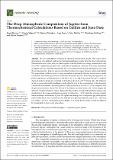Files in this item
The deep atmospheric composition of Jupiter from thermochemical calculations based on Galileo and Juno data
Item metadata
| dc.contributor.author | Rensen, Frank | |
| dc.contributor.author | Miguel, Yamila | |
| dc.contributor.author | Zilinskas, Mantas | |
| dc.contributor.author | Louca, Amy | |
| dc.contributor.author | Woitke, Peter | |
| dc.contributor.author | Helling, Christiane | |
| dc.contributor.author | Herbort, Oliver | |
| dc.date.accessioned | 2023-02-02T14:30:04Z | |
| dc.date.available | 2023-02-02T14:30:04Z | |
| dc.date.issued | 2023-02-02 | |
| dc.identifier | 283209411 | |
| dc.identifier | 679f9757-9a76-4d62-aaf0-8b1fbcf87204 | |
| dc.identifier | 85147953111 | |
| dc.identifier.citation | Rensen , F , Miguel , Y , Zilinskas , M , Louca , A , Woitke , P , Helling , C & Herbort , O 2023 , ' The deep atmospheric composition of Jupiter from thermochemical calculations based on Galileo and Juno data ' , Remote Sensing , vol. 15 , no. 3 , 841 . https://doi.org/10.3390/rs15030841 | en |
| dc.identifier.issn | 2072-4292 | |
| dc.identifier.uri | https://hdl.handle.net/10023/26890 | |
| dc.description.abstract | The deep atmosphere of Jupiter is obscured beneath thick clouds. This causes direct observations to be difficult, and thermochemical equilibrium models fill in the observational gaps. This research uses Galileo and Juno data together with the Gibbs free energy minimization code GGCHEM to update the gas phase and condensation equilibrium chemistry of the deep atmosphere of Jupiter down to 1000 bars. Specifically, the Galileo data provides helium abundances and, with the incorporated Juno data, we use new enrichment values for oxygen, nitrogen, carbon and sulphur. The temperature profile in Jupiter’s deep atmosphere is obtained following recent interior model calculations that fit the gravitational harmonics measured by Juno. Following this approach, we produced pressure–mixing ratio plots for H, He, C, N, O, Na, Mg, Si, P, S and K that give a complete chemical model of all species occurring to abundances down to a 10−20 mixing ratio. The influence of the increased elemental abundances can be directly seen in the concentration of the dominant carriers for each element: the mixing ratio of NH3 increased by a factor of 1.55 as compared with the previous literature, N2 by 5.89, H2O by 1.78, CH4 by 2.82 and H2S by 2.69. We investigate the influence of water enrichment values observed by Juno on these models and find that no liquid water clouds form at the oxygen enrichment measured by Galileo, EH2O = 0.47, while they do form at higher water abundance as measured by Juno. We update the mixing ratios of important gas phase species, such as NH3, H2O, CO, CH4 and H2S, and find that new gas phase species, such as CN−, (NaCN)2, S2O and K+, and new condensates, namely H3PO4 (s), LiCl (s), KCl (s), NaCl (s), NaF (s), MgO (s), Fe (s) and MnS (s), form in the atmosphere. | |
| dc.format.extent | 19 | |
| dc.format.extent | 1486156 | |
| dc.language.iso | eng | |
| dc.relation.ispartof | Remote Sensing | en |
| dc.subject | Solar system | en |
| dc.subject | Clouds | en |
| dc.subject | Atmospheric composition | en |
| dc.subject | Giant planets | en |
| dc.subject | QB Astronomy | en |
| dc.subject | QD Chemistry | en |
| dc.subject | T-DAS | en |
| dc.subject | NIS | en |
| dc.subject | MCC | en |
| dc.subject.lcc | QB | en |
| dc.subject.lcc | QD | en |
| dc.title | The deep atmospheric composition of Jupiter from thermochemical calculations based on Galileo and Juno data | en |
| dc.type | Journal article | en |
| dc.contributor.institution | University of St Andrews. St Andrews Centre for Exoplanet Science | en |
| dc.contributor.institution | University of St Andrews. School of Physics and Astronomy | en |
| dc.identifier.doi | 10.3390/rs15030841 | |
| dc.description.status | Peer reviewed | en |
This item appears in the following Collection(s)
Items in the St Andrews Research Repository are protected by copyright, with all rights reserved, unless otherwise indicated.

